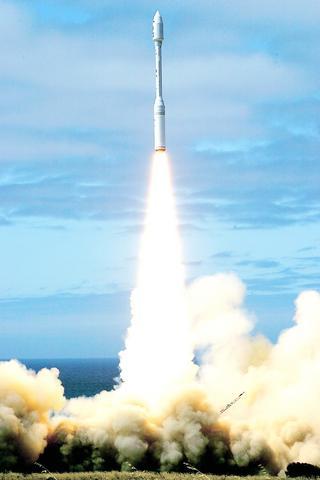ROCSAT-2, the second satellite that Taiwan has put into space, was launched yesterday in California at 1:47am Taiwan time, making the nation not only a satellite-image exporter but also a leader in the hot field of upper-atmospheric lightning research, the National Science Council said yesterday.
Celebrating the event at the headquarters of the council's National Space Program Office (NSPO) in Hsinchu -- and viewing real-time images from the launch site at Vandenberg Air Force Base -- were Wei Che-ho (

PHOTO: CNA
An improved Taurus launch vehicle operated by US Orbital Sciences Corp (OSC) -- bearing Taiwan's national flag and the imprint of the ROCSAT-2 mission -- lifted the 750kg satellite into space. Eighty-four seconds after liftoff, the launch vehicle's Stage Zero rocket had finished burning, creating a white air-current tail.
According to data sent back from the launch vehicle, ROCSAT-2 and the rocket separated 15 minutes after liftoff, at which point the satellite went into its temporary orbit 737km above the Earth -- 14km higher than expected.
Seventy-four minutes after the launch, ROCSAT-2 completed its first telemetry feedback to a ground-support station in Kiruna, Sweden.
"The successful liftoff demonstrates Taiwan's potential to upgrade its space industry," Wei said.
In the future, we are confident that domestic firms will be able to replace foreign companies and become major contractors for satellite projects," Wei said.
The satellite project, which cost NT$4.7 billion (US$142 million), was designed and built by the NSPO in collaboration with Astrium Co of France.
The project got under way in 2000.
At 8:25am yesterday, after the satellite's fourth orbit around the globe, it made contact with Taiwan for the first time, sending information to a receiving station in Chungli.
All information was transferred to NSPO headquarters in Hsinchu, allowing scientists at the NSPO's Mission Operation Center to perform a series of checks on the satellite's operations.
NSPO officials said that the satellite would be transferred to a higher orbit at 891km.
All tests on the satellite's functions will be completed within about a month. After that, the craft will begin a 5-year remote-sensing observation project and an investigation of upper-atmospheric lightning.
"Now, Taiwan will be an exporter of satellite images and a key player in investigating the mysterious phenomenon of upper-atmospheric lightning," Lee said.
President Chen Shui-bian (
"The successful liftoff is a great gift that the team has presented to Taiwan's people," Chen said.
Happiness about the launch was shared by those who had traveled to the US to observe it.
Shieh Ching-jyh (
Shieh told the Taipei Times yesterday from California that the ROCSAT-2 team had been criticized too much for a series of delays that had delayed previous launch attempts.
"Responsible engineers have to discover potential problems and fix them to ensure a successful mission," Shieh said.
"We've been doing this for a long time," Shieh said.

Taiwan is to commence mass production of the Tien Kung (天弓, “Sky Bow”) III, IV and V missiles by the second quarter of this year if the legislature approves the government’s NT$1.25 trillion (US$39.78 billion) special defense budget, an official said yesterday. Commenting on condition of anonymity, a defense official with knowledge of the matter said that the advanced systems are expected to provide crucial capabilities against ballistic and cruise missiles for the proposed “T-Dome,” an advanced, multi-layered air defense network. The Tien Kung III is an air defense missile with a maximum interception altitude of 35km. The Tien Kung IV and V

The disruption of 941 flights in and out of Taiwan due to China’s large-scale military exercises was no accident, but rather the result of a “quasi-blockade” used to simulate creating the air and sea routes needed for an amphibious landing, a military expert said. The disruptions occurred on Tuesday and lasted about 10 hours as China conducted live-fire drills in the Taiwan Strait. The Civil Aviation Administration (CAA) said the exercises affected 857 international flights and 84 domestic flights, affecting more than 100,000 travelers. Su Tzu-yun (蘇紫雲), a research fellow at the government-sponsored Institute for National Defense and Security Research, said the air

Taiwan lacks effective and cost-efficient armaments to intercept rockets, making the planned “T-Dome” interception system necessary, two experts said on Tuesday. The concerns were raised after China’s military fired two waves of rockets during live-fire drills around Taiwan on Tuesday, part of two-day exercises code-named “Justice Mission 2025.” The first wave involved 17 rockets launched at 9am from Pingtan in China’s Fujian Province, according to Lieutenant General Hsieh Jih-sheng (謝日升) of the Office of the Deputy Chief of the General Staff for Intelligence at the Ministry of National Defense. Those rockets landed 70 nautical miles (129.6km) northeast of Keelung without flying over Taiwan,

A strong continental cold air mass is to bring pollutants to Taiwan from tomorrow, the Ministry of Environment said today, as it issued an “orange” air quality alert for most of the country. All of Taiwan except for Hualien and Taitung counties is to be under an “orange” air quality alert tomorrow, indicating air quality that is unhealthy for sensitive groups. In China, areas from Shandong to Shanghai have been enveloped in haze since Saturday, the ministry said in a news release. Yesterday, hourly concentrations of PM2.5 in these areas ranged from 65 to 160 micrograms per cubic meter (mg/m³), and pollutants were